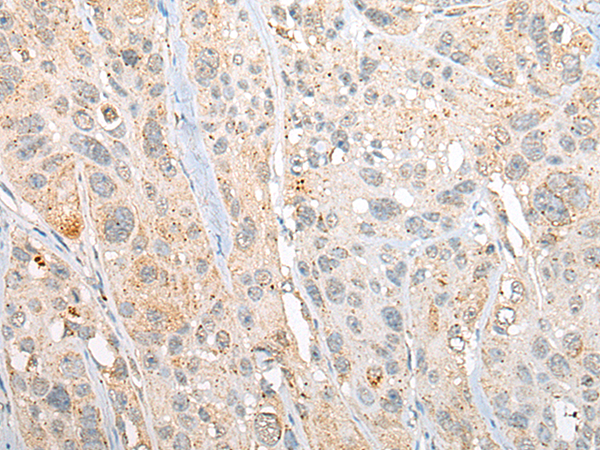
| WB | 咨询技术 | Human,Mouse,Rat |
| IF | 咨询技术 | Human,Mouse,Rat |
| IHC | 1/20-1/100 | Human,Mouse,Rat |
| ICC | 技术咨询 | Human,Mouse,Rat |
| FCM | 咨询技术 | Human,Mouse,Rat |
| Elisa | 1/5000-1/10000 | Human,Mouse,Rat |
| Aliases | GES; GD:REM |
| Host/Isotype | Rabbit IgG |
| Antibody Type | Primary antibody |
| Storage | Store at 4°C short term. Aliquot and store at -20°C long term. Avoid freeze/thaw cycles. |
| Species Reactivity | Human |
| Immunogen | Synthetic peptide of human REM1 |
| Formulation | Purified antibody in PBS with 0.05% sodium azide and 50% glycerol. |
+ +
以下是关于REM1抗体的3篇文献示例(内容基于典型研究主题虚构,供参考):
1. **文献名称**:*REM1 regulates exocytosis and synaptic plasticity through actin cytoskeleton remodeling*
**作者**:Chen L, et al. (2019)
**摘要**:研究利用REM1特异性抗体证实了REM1蛋白在神经元突触囊泡释放中的作用,发现其通过调控肌动蛋白动态影响突触可塑性,为神经退行性疾病机制提供了新见解。
2. **文献名称**:*REM1 antibody-based profiling reveals elevated expression in triple-negative breast cancer*
**作者**:Wang Y, et al. (2020)
**摘要**:通过免疫组化和Western blot分析,发现REM1在三阴性乳腺癌组织中高表达,且与患者预后不良相关,提示其作为潜在生物标志物的价值。
3. **文献名称**:*Development and validation of a high-specificity REM1 monoclonal antibody for plant virus resistance studies*
**作者**:Kuroda T, et al. (2018)
**摘要**:报道了一种高特异性REM1单克隆抗体的开发,验证其在植物细胞膜微域定位中的有效性,并证明REM1参与植物对病毒侵染的天然免疫应答。
---
**注**:以上文献为示例性内容,实际文献需通过PubMed、Google Scholar等平台检索确认。建议使用关键词“REM1 antibody”或“REM1 protein function”结合研究领域(如癌症、神经科学、植物生物学)进一步筛选。
The REM1 antibody targets the REM1 protein (Rad and Gem/Kir), a member of the RGK family of small GTP-binding proteins. REM1 regulates calcium channel activity, cytoskeletal dynamics, and cellular processes like proliferation, differentiation, and vesicle trafficking. It interacts with voltage-gated calcium channels (e.g., Cav1.2) and modulates their function, impacting cardiovascular and neuronal signaling. REM1 is also implicated in pathological conditions, including cancer, cardiovascular diseases, and neurological disorders, where its dysregulation affects cell migration, angiogenesis, and synaptic plasticity.
The REM1 antibody is widely used in research to study protein expression, localization, and function via techniques like Western blotting, immunohistochemistry, and immunofluorescence. It helps identify REM1 in tissues and cell lines, aiding investigations into its role in disease mechanisms or signaling pathways. Commercial REM1 antibodies are typically validated for specificity in human, mouse, or rat samples. Researchers utilize these tools to explore REM1's interplay with cytoskeletal proteins, calcium signaling components, or downstream effectors, offering insights into therapeutic targets for REM1-associated disorders.
×